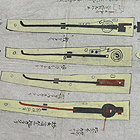Japanese Gallery (Honkan) Room 16
November 22, 2011 (Tue) - December 25, 2011 (Sun)
The primary duty of Japanese warriors was to go to war, with the basis of fighting formed by archery and horsemanship. This is shown in the fact that warriors called themselves "archers", as well as in phrases such as "way of the warrior" in which the "warrior" is someone with a bow and arrows. The first warriors, who appeared in the mid-Heian period, were depicted as firing arrows while mounted on horses. In Japan, among the terms that refer to customs or conventions there is a word meaning "ancient practices" (kojitsu). Originally this applied to the court nobles at the center of the ruling class, and a concept of "ancient practices of the court" was developed to teach court etiquette. Over time, however, warriors replaced the nobles as the ruling class, and warriors, even those who at first adhered to these ancient practices of the court, established their own systems and etiquette based on customs that they had cultivated. Representative of this development is the 13th-century document, Goseibai shikimoku (Formulary of Adjudications), which codified the customs and rules of warrior families.
Under warrior control in Japan, a feudal system founded on lord-and-retainer relationships was eventually completed with the establishment of the Edo-period Tokugawa shogunate. The conventions of warrior families were formulated as "ancient practices of warrior families", a system of etiquette that the warrior class had to follow. At first, only matters concerning fighting and the systematic regulation of the lord-and-retainer system were determined, but gradually the scope broadened to include rules about martial arts, military strategy and eventually the lifestyle of warriors. In this period, for each particular field many schools developed and much literature was produced.
This exhibition mainly displays examples of this literature about archery and horsemanship, fencing, gunnery and manners. In this way, the exhibition aims to touch on a range of world views held by the warrior class.

